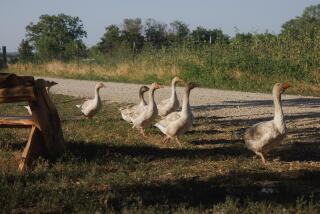Tuck it away for Arbor Day
- Share via
ONLY a blockhead can fail to recognize the importance of trees. Or perhaps, since a blockhead’s thinking organ is presumably made of wood, even a blockhead might realize how essential trees are to our planet, our species and all of the other species upon it.
For most of human history, trees were our primary source of fuel and wood one of our most essential building materials. Trees have nourished us (and our ape-like, fruit-eating ancestors), providing a dazzling array of foods such as olives, avocados, figs, mangoes, pears, apples, peaches, plums, cherries and all varieties of citrus to almonds, pine nuts, walnuts and almost every other kind of nut.
Offering shade from the sun and shelter from the rain, trees have an instinctive appeal for us. Lofty and long-lived, havens of protection and refreshment, it’s no wonder many people have worshiped them.
Trees figure prominently in the creation lore of many cultures. The Upanishads of early India tell of the tree Asvattha reaching down from the heavens into the worlds below. It was under such a tree, also called the Bodhi (a kind of fig tree) that Siddhartha Gautama, founder of Buddhism, meditated and attained Nirvana.
Ygdrasil, the giant ash tree of Norse mythology, was said to connect all nine realms of the cosmos, from the heavens to the underworld. And of course we are familiar with the Tree of Knowledge and the Tree of Life in the Garden of Eden, not to mention the fig tree that provided Adam and Eve with their first set of clothes.
Colin Tudge, a biologist who’s written books on genetics, agriculture, food supply and global ecology, believes the best way to approach the subject of trees -- or, indeed, any subject of scientific inquiry -- is in a spirit of reverence. The kind of reverence he means has nothing to do with the vague, inquiry-inhibiting awe imposed by superstition or blind faith but rather the reverent and appreciative attitude toward nature that animated the researches of Galileo, Newton, Descartes and Robert Boyle.
“So this book,” he declares, “presents science not as it is often presented, as a tribute to human cleverness and power, but truly in a spirit of reverence. I like the idea (I have found that some people don’t, but I do) that each of us might aspire to be a connoisseur of nature, and connoisseurship implies a combination of knowledge on the one hand and love on the other, each enhancing the other. Conservation -- of all living creatures, including trees -- has little chance of long-term success without understanding, which depends in large measure on excellent science. But conservation cannot even get on the agenda unless people care.”
Conservation -- and indeed the broader issue of how we can best foster and sustain that which sustains us -- is a topic Tudge specifically addresses in the concluding portion of this book. But the vast bulk of “The Tree” is devoted to explaining exactly what a tree is (the childlike definition of a tree as “a big plant with a stick up the middle” strikes him as surprisingly useful), what different kinds of trees there are, how trees go about the tasks of nourishing, reproducing and protecting themselves, and the complex and fascinating relationships trees have with other species -- from the birds, insects and mammals that help pollinate them to the parasites and pests that prey on them.
For readers in search of a quick overview, this book may provide too much information, spilling over with specifics that may indeed make it hard to see the forest for the trees. A less justifiable weakness (all information is at least potentially useful or interesting) is Tudge’s tendency to be roundabout and repetitious, as he is when explaining the difficulties of ascertaining the number of tree species or why it’s often hard to tell a species from a genus from a variety.
Tudge writes in the great tradition of naturalists such as Humboldt and John Muir, cramming his work with stories and observations that will certainly interest readers already somewhat attuned to the subject. Thus, we learn about the survival tactics of aspens, which resist fierce winds by not resisting and survive forest fires by reproducing themselves through a system of lateral underground roots and suckers. Or about how trees communicate with one another through wind-borne chemicals they produce in times of danger -- to repel predators, for instance.
The more one knows about trees, the more one realizes how important they are to us. As Tudge looks to the future, he issues an eloquent and deeply persuasive warning about what it means to be truly “realistic.” First, he warns of the dangers of mistaking urbanization and industrialization for “progress,” when farming- and agriculture-based societies are so vital to the well being of the majority of the planet’s people. Then, he makes a subtler but no less important point:
“[T]he word ‘realistic’ has been corrupted. It ought to apply to the realities that are inescapable -- of physics, of biology -- made manifest in the declining earth, and the creatures that live on it. It should apply to the realities of people’s lives -- whether they have enough to eat, and water, and shelter; whether they have control over their own lives, and worthwhile jobs, and can live in dignity. The ‘reality’ of which our current leaders speak is the reality of cash. But cash is not the reality. Cash is the abstraction.”






